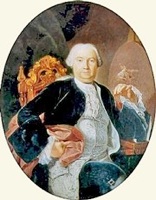
Portrait of Luigi Vanvitelli
by Giacinto Diano, Royal Palace, Caserta
The architect and engineer Lodewijk van Wittel (Luigi Vanvitelli to the Italians) was born in Naples, the son of the Dutch painter Gaspar van Wittel, who was based in Rome. He trained in there and became one of the most important Italian architects of the 18th century. The most important commission of his career was the design and construction of the Royal Palace of Caserta for King Charles VII of Naples: he won the commission in 1752 and worked on the project until his death over twenty years later.
Luigi Vanvitelli developed the careers of younger associates, which enabled him to take on work in diverse locations:
-
✴Carlo Murena trained in Rome under Luigi Vanvitelli from ca. 1737, and greatly benefitted from his subsequent support. In return, Carlo Murena managed his affairs in Rome when he was engaged in Naples and other centres.
-
✴Giuseppe Piermarini, who moved from Foligno to Rome in 1752 to study under Carlo Murena, moved from Rome to Caserta in 1765 to join the team of Luigi Vanvitelli. The two men began an association that lasted until Vanvitelli’s death. Thus, when the Emperor Joseph II commissioned Vanvitelli to remodel the Palazzo Reale in Milan in 1769, Piermarini took day-to day charge of the project and was appointed as the “Imperial Regio Architetto” of Milan. The importance of the project increased in 1771 when the Archduke Ferdinand, the brother of Joseph II and Governor of Lombardy, married Maria Beatrice d’ Este; the young couple intended to make the palace their principal residence. The two men found time to advise on the remodelling of the Duomo of Foligno (see below) during their trips between Naples and Milan in 1771-3. However, by the time that work on the palace in Milan actually began under Piermarini in 1773, Vanvitelli was dead. Foligno
Work in San Salvatore
Luigi Vanvitelli designed the Cappella della Pietà in San Salvatore in 1751.
Work in the Duomo
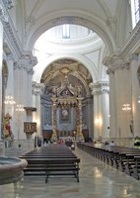
Vanvitelli visited Foligno in 1771 while en route from Naples to Milan to visit Giuseppe Piermarini. Giuseppe Piermarini agreed to take over the project in his native city, which he would supervise from Milan. Piermarini visited Foligno in 1772, en route for Naples, where he consulted Vanvitelli on changes that were needed to the original plan. Giuseppe Piermarini continued in overall charge of the project after Vanvitelli’s death in 1773.
Perugia
Monastero degli Olivetani di Montemorcino Nuovo (1740)
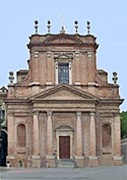
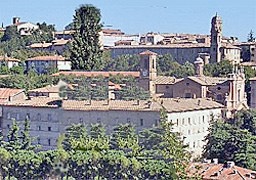
Luigi Vanvitelli designed the church and the huge adjacent monastery known as the Convento di Montemorcino Nuova for two communities of Olivetan monks that moved to this site in 1740:
-
✴one from Montemorcino (to the west of Perugia); and
-
✴the other from Sant' Antonio Abate, in the city.
It was through his good offices that the young Carlo Murena was appointed as director of the construction project. The complex was transferred to the University of Perugia in 1811. The church (which is dedicated to Santa Maria Annunziata) was restored and re-opened as the university church. Its neo-Classical façade dominates what is now Piazza dell’ Università.
Palazzo del Capitano del Popolo (ca. 1741)
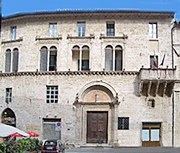
Luigi Vanvatelli designed the present third storey of Palazzo del Capitano del Popolo, after the taller original third storey was destroyed in an earthquake in 1741.



